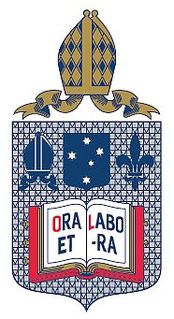Maroubra Force was the name given to the ad hoc Australian infantry force that defended Port Moresby, Papua New Guinea from the Japanese, and was involved in the Kokoda Track Campaign of the Pacific War, World War II. The force was established by the Allies under the codename "Maroubra", referring to the troops in the forward area, it was one of many units forming the body of the New Guinea Force, the main Allied army formation in the South West Pacific Area during 1942.
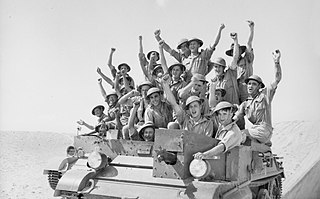
The 2/7th Battalion was an infantry battalion of the Australian Army raised for service during World War II. Formed as part of the 6th Division shortly after the outbreak of the war as part of the all-volunteer Second Australian Imperial Force, the 2/7th Battalion's initial personnel were recruited primarily from the state of Victoria, although later reinforcements were drawn from most other Australian states. Basic training was completed in Australia, after which the battalion embarked for the Middle East as part of the first batch of Australian troops to deploy overseas. Further training was undertaken in Palestine before the battalion went into action against the Italians in January 1941. After participating in the successful capture of Bardia and Tobruk, it was committed to the disastrous Battles of Greece and Crete, where the battalion was essentially destroyed after the majority of its personnel were captured.

The 2/11th Battalion was an infantry battalion of the Australian Army which saw service during World War II. Raised shortly after the outbreak of war in 1939, the 2/11th was formed from Second Australian Imperial Force volunteers who were recruited mainly from the state of Western Australia. Assigned to the 6th Division, the 2/11th completed its training in Western Australia and New South Wales before deploying to the Middle East in 1940. Its first action came around Bardia in early January 1941, and this was followed by further actions in Libya, and then Greece and on Crete during which the 2/11th suffered heavy losses. After being re-formed, in late 1941 the battalion was deployed to Syria to undertake garrison duties there. In early 1942, it was brought back to Australia to help bolster the country's defences following Japanese advances in the Pacific, and it subsequently undertook defensive duties in Western Australia. The 2/11th did not see combat again until the final year of the war when it was committed to the Aitape–Wewak campaign. It was disbanded after the war in late 1945.
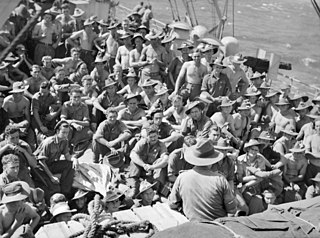
The 36th Battalion was an infantry battalion of the Australian Army. It was originally raised in 1916 as part of the First Australian Imperial Force during World War I. Throughout World War I the battalion served on the Western Front as part of the 9th Brigade, attached to the 3rd Division. Due to heavy casualties amongst the AIF and a decrease in the number of replacements arriving from Australia in 1918, the battalion was disbanded before the war ended in order to reinforce other units in France. The 36th Battalion was re-raised in 1921 as part of the Militia based in Sydney. During World War II the battalion was attached to the 14th Brigade and was initially used in a defensive role as a garrison unit in Australia before being sent to New Guinea in 1942. Throughout the course of the war in the Pacific, the 36th Battalion spent most of the 1942–45 period overseas in New Guinea and New Britain where they undertook operations against the Japanese. In June 1945 they were returned to Australia and shortly afterwards the battalion was disbanded.
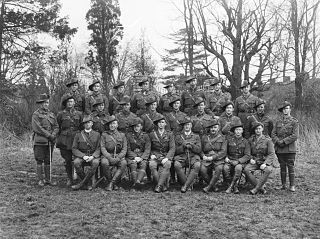
The 39th Battalion was an infantry unit of the Australian Army. It was originally raised in February 1916 for service during World War I as part of First Australian Imperial Force, with personnel being drawn mainly from the state of Victoria. Making up part of the 10th Brigade, it was attached to the 3rd Division and served on the Western Front in France and Belgium before being disbanded in March 1919. Following the re-organisation of the Australian Army in 1921, the battalion was raised again in Victoria as a unit of the Citizens Force, becoming known as the "Hawthorn–Kew Regiment". In 1937, it was amalgamated with the 37th Battalion to become the 37th/39th Battalion. Later, in August 1939 it was delinked with the 37th and amalgamated with the 24th Battalion to form the 24th/39th Battalion, before being raised again as a single unit in October 1941.

Lieutenant General Sir Carl Herman Jess, was an Australian Army officer who served in the First and Second World Wars.
The 4th Brigade is a brigade-level formation of the Australian Army. Originally formed in 1912 as a Militia formation, the brigade was re-raised for service during World War I, elements of the brigade served at Gallipoli and in the trenches on the Western Front before being disbanded in 1919. In 1921, the brigade was re-raised as a unit of Australia's part-time military forces, based in the state of Victoria. During World War II the brigade served in the New Guinea and New Britain campaigns. Following the war, the brigade formed part of the 3rd Division, however, it was later reallocated to the 2nd Division, where it serves as a Reserve combined-arms formation including units and personnel from all corps of the Army including armoured, infantry, artillery, engineers, signals and ordnance.

The 18th Brigade was an infantry brigade of the Australian Army. The brigade briefly existed as a Militia formation prior to the First World War, but this was short lived. During the Second World War, the brigade was raised on 13 October 1939 and was one of the first three infantry brigades of the Second Australian Imperial Force to be formed. Initially commanded by Brigadier Leslie Morshead, it served in the United Kingdom in 1940–1941, where it helped bolster the British garrison in anticipation of a possible German invasion following the Fall of France. In early 1941, the brigade was transferred to the Middle East where it later took part in fighting against the Italians in Libya and then helped to defend the besieged port of Tobruk before fighting against the Vichy French in the Syria–Lebanon campaign. The 18th Brigade was withdrawn to Australia in early 1942, and it later took part in the fighting against the Japanese in Pacific fighting several campaigns in New Guinea between late 1942 and early 1944. Its final involvement of the war came in mid-1945 when it took part in re-taking Balikpapan. Following the end of hostilities, the 18th Brigade was disbanded on 3 January 1946.

The 2/16th Battalion was an infantry battalion of the Australian Army, serving during World War II. Attached to the 21st Brigade that was assigned to the 7th Division, the 2/16th was raised in 1940 as part of the Second Australian Imperial Force from volunteers drawn mainly from the state of Western Australia. After training in Australia, the battalion was deployed to the Middle East where it undertook defensive duties along the Egyptian–Libyan border in early 1941 before taking part in the Syria–Lebanon campaign, fighting against Vichy French forces in June and July. At the conclusion of the campaign, the 2/16th remained in Lebanon, contributing to the Allied occupation force there, before returning to Australia in early 1942 following Japan's entry into the war. In August 1942, they were committed to the fighting along the Kokoda Track and then later fought around Buna and Gona. After a period of rest and reorganisation in Australia, the battalion fought around Lae and then took part in the Finisterre Range campaign in 1943–44. Its final campaign of the war came in Borneo in July 1945. At the end of the war, the 2/16th were disbanded in January 1946.

The 32nd Battalion was an infantry battalion of the Australian Army. It was first raised in 1915 as part of the Australian Imperial Force and was initially made up of personnel from South Australia and Western Australia. The battalion served in France and Belgium during the First World War before being disbanded in 1919.

The 2/12th Battalion was an infantry battalion of the Australian Army which served during World War II. Raised in late 1939 as part of the all volunteer Second Australian Imperial Force, the battalion's initial recruits were drawn primarily from the states of Queensland and Tasmania. Assigned to the 18th Brigade, the battalion completed basic training in Australia before embarking for overseas in May 1940.

The 22nd Brigade was a brigade-sized infantry unit of the Australian Army. It was briefly raised in 1912 as a Militia formation providing training as part of the compulsory training scheme. Later, during World War II, the brigade was raised as part of the all volunteer Second Australian Imperial Force in April 1940. Assigned to the 8th Division, in early 1941 the brigade was deployed to British Malaya where it formed part of the defensive garrison that was established there by the British, eventually establishing its headquarters in the Mersing–Endau area.
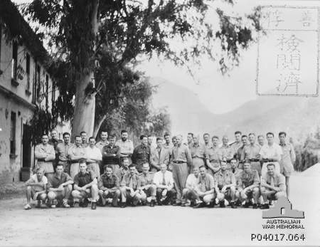
The 2/22nd Battalion was an infantry battalion of the Australian Army. Raised as part of the Second Australian Imperial Force for service during World War II, the battalion formed part of the 23rd Brigade, attached to the 8th Division. It was captured by the Japanese during the Battle of Rabaul in 1942. After being captured, the battalion was not re-raised and a large number of its personnel died in captivity; those that did not were returned to Australia at the end of the war in 1945.

Lieutenant General Sir Alwyn Ragnar Garrett, KBE, CB was a senior commander in the Australian Army. He served as Chief of the General Staff (CGS) from 1958 to 1960.

Major General John Stewart Whitelaw, was a senior officer in the Australian Army. Whitelaw was a graduate of the first intake of the Royal Military College, Duntroon and served briefly at Gallipoli with an infantry battalion during the First World War. His war service was, however, cut short by a bullet wound suffered during the landing on 25 April 1915 and he returned to Australia where, during the interwar years, he transferred to the artillery and undertook a number of staff and instructional postings. During the Second World War, although he did not serve overseas in an operational role, in his capacity as a senior artillery officer Whitelaw had responsibility for all matters relating to the development of artillery in the Australian Army and in this role he championed the introduction of new technologies and weaponry into the corps and the development of Australian defence industries.

The 2/14th Battalion was an infantry battalion of the Australian Army that served during World War II. Part of the 21st Brigade, 7th Division, the battalion was raised from Second Australian Imperial Force volunteers drawn mainly from the state of Victoria. After completing training in Australia in 1940, the battalion deployed to the Middle East where it was stationed in Egypt and Palestine before it saw action against the Vichy French in Syria in June and July 1941, in a short lived campaign. Garrison duties in Lebanon followed before the battalion was withdrawn to Australia in early 1942 as Australian forces were concentrated in the Pacific to respond to the threat posed by Japan's entry into the war.

The 2/24th Battalion was an infantry battalion of the Australian Army, which served during World War II. A unit of the all-volunteer Second Australian Imperial Force, it was formed in July 1940 from primarily Victorian volunteers and was known as "Wangaratta's Own" because of the time the battalion spent in the town during its formative period prior to deployment overseas. It served in North Africa in 1941–1942 as part of the 26th Brigade, which was assigned to the 7th Division, before being reassigned to the 9th Division. In early 1943, the battalion returned to Australia and later took part in campaigns against the Japanese in New Guinea in 1943–1944 and Borneo in 1945, before being disbanded in 1946. The 2/24th suffered the highest number of casualties of any 2nd AIF infantry battalion.
Major General Bruce Alexander McDonald, was a senior officer in the Australian Army, seeing service in the Second World War, the Indonesia-Malaysia Confrontation and the Vietnam War.

The 2nd Pioneer Battalion was an Australian infantry and light engineer unit raised for service during the First World War as part of the all volunteer Australian Imperial Force (AIF). Formed in Egypt in March 1916, the battalion subsequently served on the Western Front in France and Belgium, after being transferred to the European battlefields shortly after its establishment. Assigned to the 2nd Division, the 2nd Pioneer Battalion fought in most of the major battles that the AIF participated in between mid-1916 and the end of the war in November 1918. It was subsequently disbanded in early 1919.

The 4th Machine Gun Battalion was an infantry support unit of the Australian Army. Originally formed in March 1918 for service during World War I as part of the all volunteer Australian Imperial Force, it was one of five such units raised as part of the AIF during the war. The battalion consisted of four machine gun companies, which had previously existed as independent companies assigned mainly at brigade level. The battalion took part in the final stages of the war, seeing action during the Allied defensive operations during the German Spring Offensive and then the Allied Hundred Days Offensive, which finally brought an end to the war. The battalion was disbanded in mid-1919 during the demobilisation of the AIF following the conclusion of hostilities.



